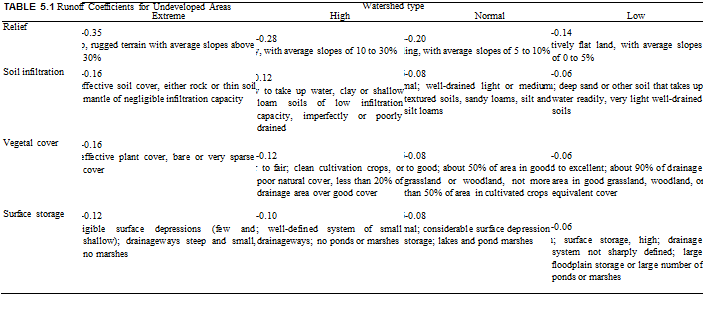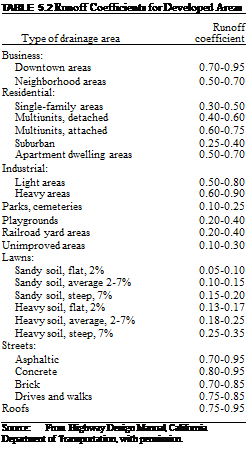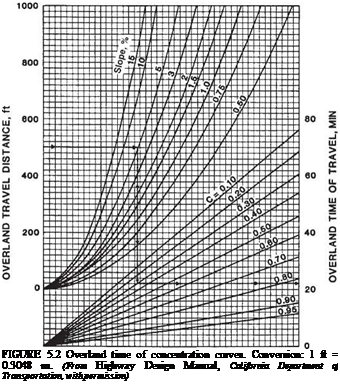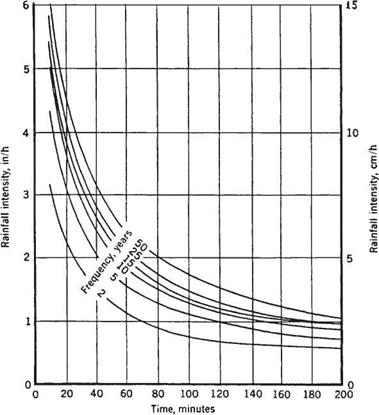Estimation of Time of Concentration
The time of concentration or rainfall duration is equivalent to the length of time it takes for the runoff to travel from the most remote point of the watershed to the point of solution. This assumes that there is a uniform rate of rainfall over the entire watershed resulting in the maximum flow at the point being investigated. The total time of concentration is comprised of three distinct components: overland flow time, shallow concentrated flow time, and concentrated flow time.
Overland flow is thought to occur for no more than 300 ft (91 m) and perhaps even less. The overland flow time may be approximated by the curves in Fig 5.2. It is based on the following equation:
![]() T = 1.8(1.1 – C)(L)1/2 o [N(100)]1/3
T = 1.8(1.1 – C)(L)1/2 o [N(100)]1/3
where To = overland flow travel time, min C = runoff coefficient L = overland travel distance, ft (m X 3.28)
S = slope
 |
|
Given: An undeveloped watershed consisting of (1) rolling terrain with average slopes of 5%, (2) clay-type soils, (3) good grassland area, and (4) normal surface depressions.
 Find: The runoff coefficient C for the above watershed.
Find: The runoff coefficient C for the above watershed.
Source: From Highway Design Manual, California Department of Transportation, with permission.
 |
The overland flow time can also be calculated by the kinematic wave equation:
![]() T = K(L06)(n06) o (i°’4)(S03)
T = K(L06)(n06) o (i°’4)(S03)
 overland flow travel time, min
overland flow travel time, min
0.93 for U. S. Customary units (6.98 for SI units)
length of overland flow path, ft (m)
slope of overland flow
Manning’s roughness coefficient
rainfall intensity, in/h (mm/h)
The solution of the kinematic wave equation is an iterative procedure since the overland flow time is a function of the rainfall intensity and the rainfall intensity is a function of the time of concentration.
|
FIGURE 5.1 Typical rainfall intensity-duration-frequency curves. (From Design and Construction of Storm and Sanitary Sewers, ASCE, 1986, with permission) |
Caution is urged in the application of this equation. Manning’s roughness coefficient n varies with the depth of flow. Therefore, n values suitable for open-channel flow should not be used in the kinematic wave equation. Table 5.3 lists roughness coefficient values appropriate for use.
After 200 to 300 ft (61 to 91 m) of overland flow, water tends to concentrate into rills and gullies. This type of flow is termed shallow concentrated flow. The velocity of shallow concentrated flow can be estimated using the following relationship:
V = KCkVl00S (5.6)
where V = velocity, ft/s (m/s)
K = 3.28 (1.0 in SI units)
Ck = intercept coefficient (see Table 5.4)
S = slope, ft/ft (m/m)
The final type of overland flow to investigate is flow that is captured in a stream, ditch, or closed conduit. This type of flow is referred to as concentrated flow.
Manning’s equation is used to estimate the velocity of concentrated flow (see Art. 5.3.3). It should be noted that the use of Manning’s equation is an iterative process and the assumed hydraulic radius must be checked for convergence.
The shallow concentrated flow time and the concentrated flow time can be determined by using the velocities obtained from the investigation of the shallow concentrated flow and the concentrated flow. The appropriate equation is as follows:
![]()
 |
L
60V
where Tf = time of shallow concentrated flow or concentrated flow, min L = overland length of flow, ft (m)
V = velocity, ft/s (m/s)
The total time of concentration is then the summation of the times of concentration for each of the distinct flow types.
As an alternative to the above procedure, where the channels are well defined and the overland flow is generally over bare ground, the total time of concentration may be estimated from the Kirpich equation[6]:
|
TABLE 5.3 Manning’s Roughness Coefficient, n, for Overland Sheet Flow
*When selecting n, consider cover to a height of about 1 in. This is the only part of the plant cover that will obstruct sheet flow. |
Source: From Urban Drainage Design Manual, HEC
22, FHWA, with permission.
![]() time of concentration, min
time of concentration, min
0.0078 for U. S. Customary units (3.97 for SI units)
maximum flow length, ft (km)
total slope = total change in elevation divided by L
The value of Tc should be multiplied by 2 where the surfaces are grassy, by 0.4 where they are asphalt or concrete, or 0.2 for concrete channels. (See Modern Sewer Design, AISI.)
The total time of concentration may also be calculated from the following modified form of the Williams equation*:
|
TABLE 5.4 Intercept Coefficients
Source: Adapted from Location and Design Manual, Vol. 2: Drainage Design, Ohio Department of Transportation, with permission. |
Tc = KLA-0lS-02 (5.9)
where Tc = time of concentration, min
K = 21.3 for U. S. Customary units (14.6 for SI units)
L = maximum flow length, mi (km)
A = total watershed area, mi2 (km2)
S = slope
A minimum time of concentration of 5 min is recommended by the FHWA. (See D. R. Maidment, Handbook of Hydrology, McGraw-Hill, 1993.)
Another common and simple method for determining the runoff is the NRCS method. The determination of the peak discharge is dependent upon the time of concentration, the cumulative rainfall, and the soil and cover classifications. (See the following from the NRCS: National Engineering Handbook, 1985; and “Urban Hydrology for Small Watersheds,” TR-55, 1986.)







Leave a reply